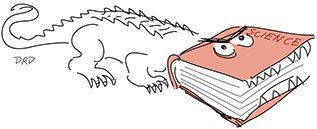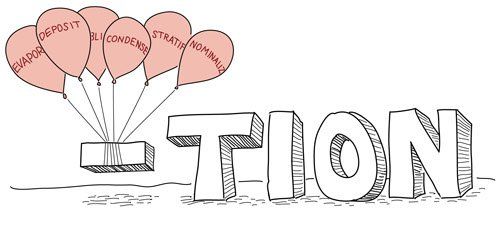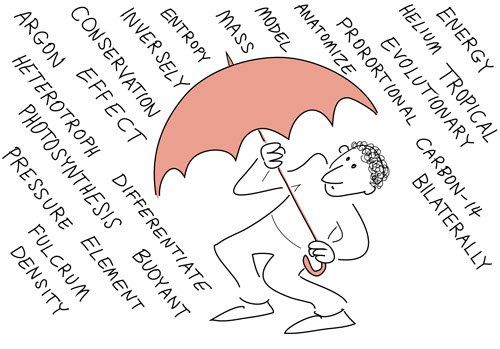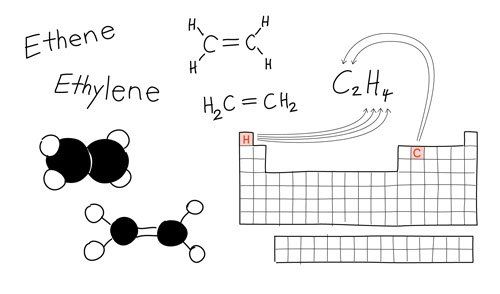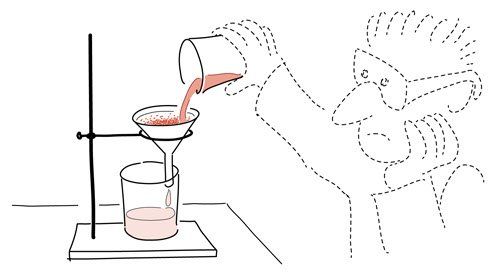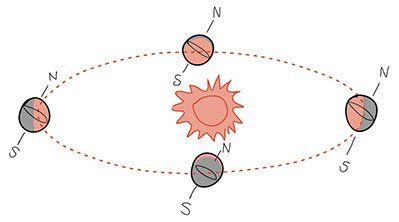What special challenges do science texts typically pose for students?
Science texts often pose a number of challenges to the uninitiated. There can be difficult new words, or familiar words with unfamiliar meanings. Abstract nouns swallow up complex processes, and passive verbs conceal the doers of deeds. Text sits cheek by jowl with other modes of representation in ways that are supposed to clarify information, but that may require new interpretive skills. Below are brief discussions of some of these challenges.
Academic and Scientific Language
Science texts use lots of unfamiliar terms. While these terms support clear, precise communication for the initiated, they are like a foreign language for students. Students need help learning to interpret scientific vocabulary through the use of visual representations, identification of common prefixes and suffixes, or discussion of the different meanings words can have in different contexts.
Logical Connectives
Logical connectives, such as coordinating and subordinating conjunctions, help to clarify relationships.
- Jack left and Jill arrived.
- Jack left because Jill arrived.
- Jack left even though Jill arrived.
Students need to learn the meaning of the logical connectives they encounter, but science textbooks for children often present an opposite problem: missing logical connectives. In an effort to improve accessibility for struggling readers, textbook editors may remove logical connectives, breaking complex sentences to simple, independent clauses. This kind of simplification can be a double-edged sword, though, according to linguistic research. When you change
The earth goes through different seasons because it tilts on its axis.
to
The earth goes through different seasons. It tilts on its axis.
You get rid of a complex sentence; but you also get rid of the main point: the because, the causal relationship between the two clauses. Science teachers may need to help their students spot the underemphasized relationships in science texts.
Polysemy
Many words have multiple meanings. While terms like power, organic, and theory might have relatively fixed meanings when used in scientific discourse, these same well-traveled words bring baggage from many other contexts. Students need to learn the science-specific definitions of such words, and they also need to learn how to interpret polysemous words appropriately according to context. For example, only the third sentence below uses the word organic in its narrow scientific sense:
- Most of the scenes were organic to the plot of the movie, but the director left in a few that seemed gratuitous.
- When she took up organic farming, she stopped using synthetic pesticides and fertilizers and turned her chickens loose to prey on the pests and manure the crops
- Many organic compounds, such as hydrogen cyanide (HCN), are extremely toxic.
Nominalization
For the sake of efficiency, specialists in science and other fields often pack descriptions of complex processes into single nouns, a process called nominalization. The word nominalization is itself an example of nominalization, standing in, as it does, for a complex linguistic practice.
Geologists can just toss off the term stratification instead of going into lengthy descriptions of wind and water depositing layers (strata) of different material over time. Chemists use words like evaporation, condensation, sublimation, and deposition instead of getting bogged down in elaborate descriptions every time they need to mention a phase change.
Nominalizations become transparent and helpful to the initiated, increasing the density of information. But they can present an opaque barrier to students. Nominalization conceals agency—who is doing what?—and converts concrete events into abstractions. Students need their teachers to help them unpack the meaning of nominalizations.
Lexical Density
The ratio of content words (nouns, adjectives, verbs, and adverbs) to function words (pronouns, prepositions, auxiliary verbs, determiners, exclamations, and conjunctions) is called lexical density. More content words mean greater density. Compared to typical narrative texts that students read, science texts tend to have high lexical density, with lots of challenging vocabulary that defies skimming. Students need to learn what the words mean, but even if they know the vocabulary they must learn to read dense text relatively slowly, breaking, annotating, reflecting, and rereading.
Multimodality
The content of science is a heavy burden for words alone to bear, and so science texts resort to other modes of communication as well. Chemical symbols represent the elements, illustrations range from the relatively concrete to the abstract and schematic, graphs and charts represent a multitude of patterns, and mathematical notations capture systematic relationships. Molecules can be represented in space-filling models to emphasize their overall shape, ball-and-stick models to emphasize the geometry of their bonds, or structural formulas that are a hybrid of text and schematic illustration. The various representations in a science text can reinforce each other, illuminate different aspects of a phenomenon or idea, and meet the needs of students with various learning styles; but the multimodality of these texts can also be challenging. Students must strive to integrate and interpret multiple channels of a semiotic symphony.
Passive Voice
Scientific texts such as reports, explanation, and experimental write-ups commonly employ the passive voice to bolster a sense of objectivity.
Ideally, the results of an experiment should not depend on who performs it; data observed in nature should be a property of nature, not of the observer. Scientists often use the passive voice (“the precipitate was filtered,” “radiation was detected,” “fossilized remains were found below this strata”) to minimize the sense of human agency in the phenomena they report. This absence of agency is the opposite of what students are used to from reading, say, fiction ("Larry the lab tech heaved a sigh and, for the hundredth time, filtered the precipitate").
One can debate whether the passive voice is overused in science writing (and lots of other writing). But it is probably appropriate a lot of the time (tell us about the precipitation reaction, not about Larry!), and in any case students need to get comfortable reading it.
Misleading Visuals
Scientific communication increasingly relies on visualizations, whether still, animated, or interactive. The saying goes that a picture is worth a thousand words, and illustration can certainly be an effective tool of science education. However, visual representations can also baffle or mislead students. Teachers can help by providing explicit instruction on how to interpret visual representations.
For example, where do students get the incorrect idea that the cycle of the seasons is caused by variation in the earth’s distance from the sun throughout the year? One contributing culprit may be the frequent schematic illustration of the earth’s orbit around the sun viewed in perspective, from slightly above the earth’s plane of orbit. This perspective shows the earth’s orbit as an ellipse with the sun at the center. Students may not understand the perspective in such images, and may think that the exaggerated ellipse shows a “top” view (from solar north or south) of the earth’s orbit.
It’s not that this way of illustrating the orbit of planets is bad. It can actually make it easier to show how the tilt of the earth’s axis causes seasonal variation in sunlight in the earth’s northern and southern hemispheres. The point is simply that pictures are not always as self-explanatory as we may think they are. A picture may be worth a thousand words, but it may still call for additional discussion.
Development of Reading to Learn in Science was led by Jonathan Osborne (Stanford University) through a SERP collaboration. Support for Reading to Learn in Science was provided by the Institute of Education Sciences, U.S. Department of Education through grant number R305F100026. The information provided does not represent views of the funders.
The emphasis of the RTLS project is on disciplinary literacy at the 4th to 8th grade level.
This work is licensed under a Creative Commons Attribution-NonCommercial-ShareAlike 4.0 International License.
